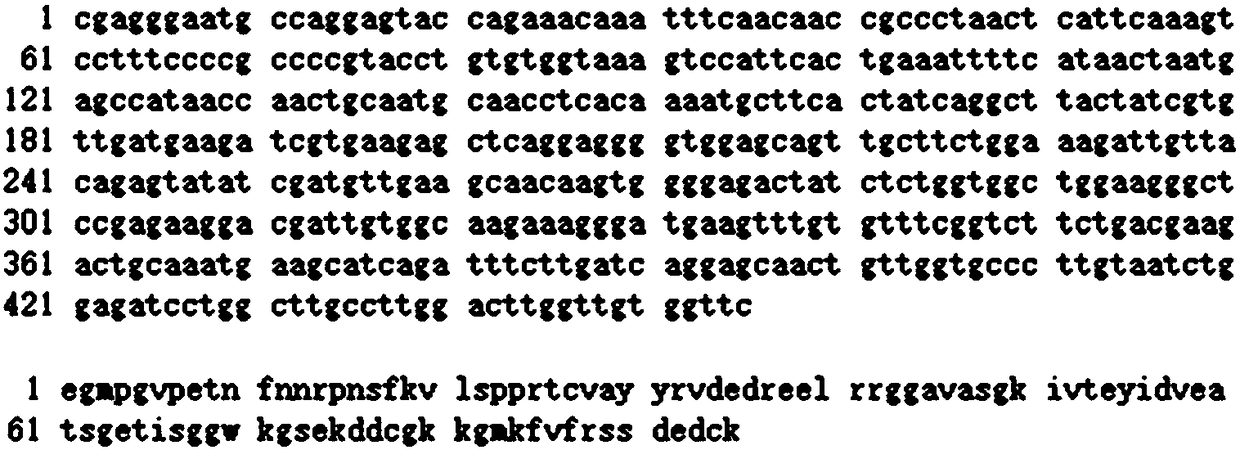Method for improving starch quality in rice
A starch and quality technology, applied in the field of plant genetic engineering in molecular biology, can solve problems such as the reduction of mature mRNA, affect the amylose content, and reduce the accumulation of GBSS, so as to achieve short improvement cycles, promote human health, and improve quality. Effect
- Summary
- Abstract
- Description
- Claims
- Application Information
AI Technical Summary
Problems solved by technology
Method used
Image
Examples
Embodiment 1
[0063] Embodiment 1: the construction of recombinant vector and the establishment of transformed Agrobacterium:
[0064] (1), the plasmid Puc18-Glb with the glutenin GluB-1 promoter (Glb) (according to EMBL sequence X5433314 carries out PCR amplification and clones on the Puc18 vector (Takara company product), the method refers to Lee et al, 2001, Constitutive and seed-specific expression of a maize lysine) was digested with EcoRI and Hind III, separated and recovered the target fragment, and connected with pCAMBIA1300 (Cambia company product) after double digestion with EcoRI and Hind III to form an intermediate vector with T4 ligase, Then the cDNA fragment of SBE1 gene (for the sequence see figure 1 ) was digested with KpnI and SacI, separated and recovered the target fragment, connected with the intermediate vector with KpnI and SacI and connected with T4 ligase to form a recombinant vector, the above restriction enzymes (EcoRI, Hind III, KpnI and SacI) and T4 ligase were ...
Embodiment 2
[0068] Example 2: Agrobacterium-mediated genetic transformation:
[0069] (1), induction:
[0070] The mature rice variety Wuyujing No. 7 seeds were shelled, then treated with 70% ethanol by volume for 1min, and the surface of the seeds with 2% sodium hypochlorite (NaClO) was sterilized for 15min; the seeds were washed 4-5 times with sterilized water; The seeds were placed on the japonica rice induction medium; the inoculated medium was placed in a dark place for 4 weeks at a temperature of 26°C.
[0071] (2), Succession:
[0072] Select bright yellow, compact and relatively dry embryogenic calli, put them on the subculture medium of japonica rice in the dark, and cultivate them at 26°C for 2-3 weeks.
[0073] (3), pre-cultivation:
[0074] Select compact and relatively dry embryogenic calli, put them on the japonica rice pre-medium in the dark, and cultivate them for 4-5 days at 26°C.
[0075] (4), Agrobacterium culture:
[0076] Pre-cultivate Agrobacterium strain S1 on ...
Embodiment 3
[0088] DNA was extracted from leaves of transgenic plants, and polymerase chain reaction (PCR) was performed. PCR program: 94°C pre-denaturation for 5 minutes; 33 cycles (94°C denaturation for 1 minute; 55°C annealing for 1 minute; 72°C extension for 2 minutes, 72°C extension for 7 minutes; ).
PUM
 Login to View More
Login to View More Abstract
Description
Claims
Application Information
 Login to View More
Login to View More - R&D
- Intellectual Property
- Life Sciences
- Materials
- Tech Scout
- Unparalleled Data Quality
- Higher Quality Content
- 60% Fewer Hallucinations
Browse by: Latest US Patents, China's latest patents, Technical Efficacy Thesaurus, Application Domain, Technology Topic, Popular Technical Reports.
© 2025 PatSnap. All rights reserved.Legal|Privacy policy|Modern Slavery Act Transparency Statement|Sitemap|About US| Contact US: help@patsnap.com



